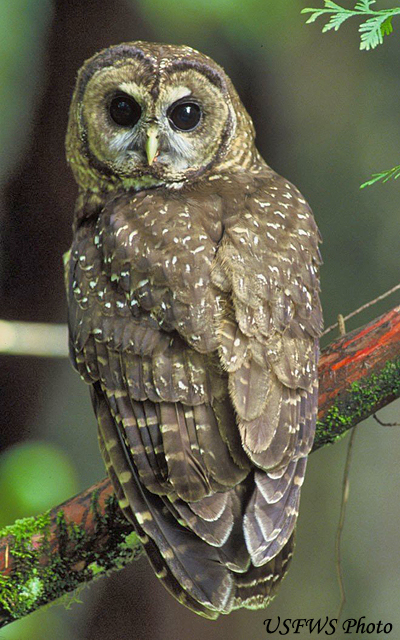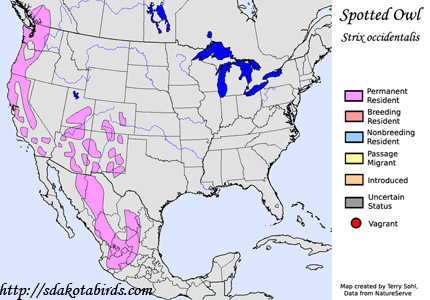| Length: 18 inches | Wingspan: 40 inches | Seasonality: Non-resident in South Dakota |
| ID Keys: Dark eyes, spotted belly and flanks, dark brown upperparts | ||
 The
Spotted Owl is a bird of the western U.S. and Mexico with three distinct
populations. The "Mexican Spotted Owl" is found in the desert
southwest of the U.S. and in northern and central Mexico. The
"California Spotted Owl" is found in California. The "Northern Spotted
Owl" is found from northern California through southern British Columbia.
There are minor plumage and size differences between the subspecies, The
Northern Spotted Owl is the darkest overall and has relatively small white
spots. The California Spotted Owl is lighter in color, and has larger
white spots. The Mexican Spotted Owl is smaller than the other two
subspecies, and has the largest white spots.
The
Spotted Owl is a bird of the western U.S. and Mexico with three distinct
populations. The "Mexican Spotted Owl" is found in the desert
southwest of the U.S. and in northern and central Mexico. The
"California Spotted Owl" is found in California. The "Northern Spotted
Owl" is found from northern California through southern British Columbia.
There are minor plumage and size differences between the subspecies, The
Northern Spotted Owl is the darkest overall and has relatively small white
spots. The California Spotted Owl is lighter in color, and has larger
white spots. The Mexican Spotted Owl is smaller than the other two
subspecies, and has the largest white spots.
All three subspecies have declined in number, but it is the Northern Spotted Owl that has declined the most. They are considered endangered in Canada and Threatened in the U.S. Conservation efforts focused on the Northern Spotted Owl have caused significant controversy in the Pacific Northwest. The Northern Spotted Owl requires large tracts of old-growth forest, a type of forest land that is extremely valuable for commercial timber companies. After multiple reviews by U.S. Fish and Wildlife, the Northern Spotted Owl was listed as "threatened" under the Endangered Species Act in 1990. Conservation planning to preserve the species culminated in the 1994 Northwest Forest Plan, which greatly restricted forest cutting in old-growth forests of the Pacific Northwest.
However, despite significant reductions in forest cutting and preservation of remaining old-growth forests, the species continues to sharply decline. Old growth forest in the Pacific Northwest is still much lower than it was historically, and continued forest cutting occurs in the region, mostly on private lands. Northern Spotted Owls have also been subject to increased competition with Barred Owls, which have begun to expand their range into the core range of the Northern Spotted Owl. Controversy continues as plans for protecting the species continue to shift. During the Bush administration, in 2007, the Fish and Wildlife Service announced plans to shift the focus of Northern Spotted Owl conservation from habitat protection, to "containment" of the Barred Owl. With the new focus, the FWS also announced plans to reduce habitat protection for the species by 1.5 million acres, which would have resulted in a loss of almost 1/4th of the species core habitat area. Numerous scientific studies and reviews of the proposed changes resulted in a challenge to the proposed changes, with indications that political pressure to open up more forest for logging were weighed more heavily than the actual science behind conserving the species. When the Obama administration took over, they overturned the decision to increase logging on many public lands. Multiple conservation proposals continue to be discussed, and the controversy over protection measures for the species continues to this day.
Habitat: Found in old-growth conifer forest in the Pacific Northwest. In the southwestern United States and Mexico, they are found in forested canyons and forested mountain slopes, preferring forest areas with large trees.
Diet: Feeds mostly on small mammals such as mice, woodrats, voles, and shrews, sometimes taking prey as large as rabbits. They will also take small birds, large insects, snakes, and amphibians.
Behavior: Nocturnal during most of the year, but will hunt during the day or night during the summer breeding season. Hunting technique usually is observing from a high perch and swooping down to capture prey when it is spotted.
Nesting: The nest of a Spotted Owl is in a large crevice in a tree, a cave, or on a cliff face, or sometimes they will make use of a large stick nest of another large bird species such as a hawk. The female usually lays 2 eggs, and she alone incubates them. After the eggs hatch, the female initially stays with the young while the male gathers food for the family. The female also will hunt for food after about 2 weeks. The young leave the nest after 4 or 5 weeks, but will continue to be fed by the parents for many weeks after.
Song: The Spotted Owl has deep, loud hooting, consisting of monotone notes with pauses in between.
Migration: Considered a permanent resident in most areas, but some birds that summer at higher elevations may move to lower elevations for the winter.
Interactive eBird map: Click here to access an interactive eBird map of Spotted owl sightings
Similar Species: Most similar to the Barred Owl.
Conservation Status: The Northern Spotted Owl, the subspecies found in the Pacific Northwest, is considered endangered. The overall population of Spotted Owl are considered "Near Threatened" by the IUCN.
Further Information: 1) BirdWeb.org - Spotted Owl
2) Audubon Guide - Spotted Owl
3) WhatBird - Spotted Owl
Photo Information: U.S. Fish and Wildlife Photo - Public Domain
| Click below for a higher-resolution map |
 |
| South Dakota Status: Non-resident in South Dakota |
Additional Spotted Owl Photos (coming soon!!)
